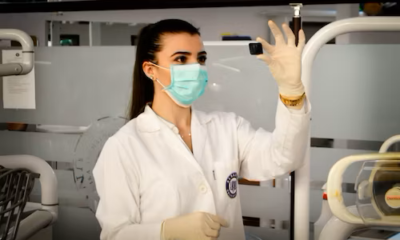Science
92career: Unveiling the Path to Success

Introduction
Welcome to the ultimate guide on carving out a successful 92career.
Whether you’re a recent graduate or a seasoned professional, this
article is your roadmap to achieving excellence in your chosen field.
We’ll explore every aspect of the 92career journey, providing
valuable insights, tips, and answers to frequently asked questions.
Navigating Your 92career Journey
Setting Your Goals
Define your aspirations and long-term objectives. A clear sense
of purpose is crucial for charting a successful 92career path.
Building a Strong Foundation
Explore the educational prerequisites and certifications required
for your specific field. A solid foundation is essential for growth.
Networking and Connections
In today’s interconnected world, networking is key. Learn how
to expand your professional circle and tap into valuable
opportunities.
Gaining Practical Experience
Hands-on experience is invaluable. Discover strategies for securing
internships or entry-level positions in your desired industry.
Continuous Learning
A 92career is a journey of constant growth. Explore options for
further education and skill development.
Work-Life Balance
Maintaining equilibrium between your professional and
personal life is vital for long-term success. Learn how to
strike the right balance.
Mastering the Art of Job Search
Crafting an Impressive Resume
Your resume is your first impression. Discover the art of creating
a compelling CV that stands out to potential employers.
Acing Interviews
Prepare to shine in interviews with expert tips and insights
into common interview questions.
Salary Negotiation
Learn how to negotiate your salary effectively and secure the
compensation you deserve.
FAQs about 92career
Q: What industries fall under the category of 92career?
A: The term “92career” is broad and can encompass
various industries, including technology, healthcare,
finance, and more.
Q: How do I stay motivated during my 92career journey?
A: Staying motivated involves setting clear goals, celebrating
small victories, and seeking inspiration from mentors and
successful professionals.
Q: Is it necessary to switch jobs frequently for career growth?
A: Not necessarily. Job hopping should be strategic and
aligned with your long-term goals.
Q: Can I pursue a 92career without a college degree?
A: While a degree can be beneficial, some industries
value skills and experience more. Consider alternative
educational paths and certifications.
Q: How do I overcome workplace challenges and conflicts?
A: Effective communication, conflict resolution skills, and
seeking guidance from HR or mentors can help navigate
workplace challenges.
Q: What are the top qualities of a successful 92career professional?
A: Adaptability, resilience, strong work ethic, and continuous learning
are among the qualities that define successful 92career professionals.
Conclusion
Embarking on a 92career journey is both exciting and challenging.
With the insights and guidance provided in this article, you are well-
equipped to navigate the twists and turns of your chosen field.
Remember, success is a journey, not a destination. Keep learning,
growing, and adapting, and you’ll find yourself on the path to a
thriving 92career.
Science
The Art and Science of Increasing Customer Value

Introduction:
In the modern business landscape, creating sustainable growth requires a deep understanding of
customer value and its impact on long-term success. Customer Lifetime Value (LTV) is a critical
metric that measures the value a customer brings to a company over the course of their entire relationship.
By accurately calculating LTV, businesses can make informed decisions to optimize their marketing strategies,
product offerings, and customer retention efforts. This article explores the art and science behind increasing
customer value through effective LTV calculation for sustainable growth.
I. Understanding Customer Lifetime Value (LTV):
Customer Lifetime Value represents the total revenue a business can expect to generate from a single
customer throughout their engagement with the company. It takes into account not only the initial purchase
but also subsequent purchases and the potential for referrals. Calculating LTV involves several key components:
- Average Order Value (AOV): The average amount a customer spends per transaction.
- Purchase Frequency (PF): How often a customer makes a purchase within a given time frame.
- Customer Lifespan (CL): The duration of the customer’s engagement with the company.
II. The Art of Increasing Customer Value:
- Segmentation and Targeting: By segmenting customers based on their behavior, preferences, and
- demographics, businesses can tailor their marketing efforts and product offerings to specific groups,
- thereby increasing customer engagement and retention.
- Personalization: Personalized experiences, whether through product recommendations, targeted marketing,
- or customized communication, can enhance customer satisfaction and loyalty.
- Exceptional Customer Service: Providing excellent customer service not only resolves issues promptly
- but also builds trust and fosters long-lasting relationships.
- Loyalty Programs: Implementing rewards, discounts, and loyalty programs encourages repeat purchases
- and higher customer retention rates.
- Upselling and Cross-selling: Analyzing customer data can help identify opportunities to offer complementary
- products or upgrade customers to higher-tier offerings.
III. The Science of Calculating LTV:
- Data Collection: Collect comprehensive data on customer transactions, behaviors, and interactions
- to establish accurate baseline metrics.
- LTV Calculation Methods: a. Historic LTV: Based on historical customer data, this method calculates
- the average revenue generated by a customer over a specific period. b. Predictive LTV: Utilizes machine
- learning algorithms to forecast future customer behavior and estimate their potential value.
- Variables to Consider: a. Churn Rate: The rate at which customers stop engaging with the company. b.
- Discount Rate: Adjusts future cash flows to account for the time value of money. c. Customer Acquisition
- Cost (CAC): The cost of acquiring a new customer.
- Monitoring and Iteration: Regularly update LTV calculations as customer behavior evolves, and refine strategies
- to maximize value based on insights gained.
IV. Case Studies: Provide real-world examples of companies that successfully increased customer
value through accurate LTV calculations. Highlight how their strategies led to sustained growth,
improved customer loyalty, and enhanced profitability.
V. Conclusion: In the journey towards sustainable growth, mastering the art and science of increasing
customer value is paramount. Calculating Customer Lifetime Value empowers businesses to make informed
decisions that result in personalized experiences, effective marketing, and customer-centric strategies.
By fostering strong customer relationships and optimizing LTV, companies can achieve lasting success in today’s competitive market.
-

 Education6 months ago
Education6 months agoUTI Blackboard: Navigating the Future of Online Learning
-

 Health9 months ago
Health9 months agoNow Foods Prostate Health Support – 180 Softgels KSA: Comprehensive Review and Benefits
-

 News6 months ago
News6 months agoOutline for the Article on “λιβαισ”
-

 Technology6 months ago
Technology6 months agoUnlocking the Potential of Innocams: A Comprehensive Guide
-

 Fashion8 months ago
Fashion8 months agoAll About VIP Nails
-

 Food5 months ago
Food5 months agoNoodlemagazine Guide: Unveiling the Culinary Delight
-

 Business6 months ago
Business6 months agoGuide to Boiler Steelvirgamet.com
-

 Food6 months ago
Food6 months ago18-Year-Old Tiana’s Sweet Fresh Cookies: A Sweet Symphony of Flavor and Tradition



